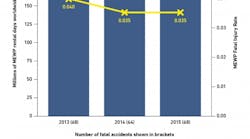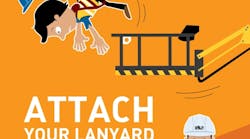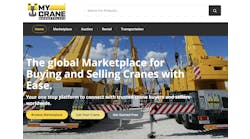Fatality Rate on Aerial Work Platforms Declines, IPAF Reports
The number of fatal injuries for mobile elevating work platforms improved slightly in 2015; while the number of fatalities remained constant the quantity of machines in use has increased, according to data released by the International Powered Access Federation.
For 2015, the number of days a rented MEWP, or aerial work platform (AWP), was operated was 192.2 million and the number of reported fatalities was 68, for a fatal injury rate of 0.035. Of the 68 reported AWP fatalities for 2015, the main causes were overturn, falls from height, electrocution and entrapment.
In 2014, rented machines were operated 182.4 million days, with 64 reported fatalities, also for a 0.035 fatal injury rate. In 2013, there were 68 fatalities in 168.4 million days of rental operation for a 0.040 fatal injury rate.
The accident data from 2013 to 2015 show that the main causes of MEWP-related fatalities were: falls from height (31 percent); overturn (27 percent); electrocution (15 percent) and entrapment (15 percent).
The MEWP/AWP fatal injury rate as calculated by IPAF takes into account the following:
- Estimated rental fleet size, based on the IPAF Powered Access Rental Market Reports (www.ipaf.org/reports)
- Estimated average utilization rates per country and worldwide (utilization rate defined as the share of the fleet on rent at any given time)
- Average days worked per year
- The number of fatalities involving aerials in a given year based on the IPAF reporting project (www.ipaf.org/incident.)
All manufacturers, rental companies, contractors and end users are encouraged to report any known accidents involving mobile elevating work platforms and mast-climbing work platforms – not only fatal or serious accidents – so that data can be used to make the aerial industry safer.










